Lighting systems
Lighting systems
Lighting systems are designed and installed for several purposes and in accordance with to different requirements.
Examples of lighting systems are work-lighting where the type of work determines the lighting level, orientation-lighting to guide the way without disturbing others and emergency lighting and low level escape lighting for abandoning spaces in case of emergency.
1. Lighting systems
The following lists give a first guidance for lighting levels in work areas. Final figures must be obtained from the applicable Rules & Regulations under contract.
1.1. Living areas:
| Captain class dayroom | 150 lx |
| Captain class bedroom | 100 lx |
| Cabin | 100 lx |
| State -/passenger room | 100 lx |
| On desk | 250 lx |
| Berth at pillow | 200 lx |
| Mirror front | 200 lx |
| Bathroom | 50 lx |
| Lavatory/ toilet | 50 lx |
| Barber shop | 200 lx |
| Dining saloon/messroom200 lx | |
| Dining table | 250 lx |
| Recreation room | 200 lx |
| Gymnasium | 200 lx |
| Bars/lounges | 50 lx |
| Shopping area | 200 lx |
| Passages/ alleyways | 50 lx |
| Staircases | 50 lx |
| Passenger entrance | 100 lx |
| Outer passage | 10 lx |
| Swimming pool | 50 lx |
1.2. Navigation area:
| Wheelhouse | 50 lx |
| Chart room | 50 lx |
| Chart table | 250 lx |
| centre spotlights Radio operator table | 250 lx |
| centre spot lights Pilot house | 200 lx |
1.3. Service areas
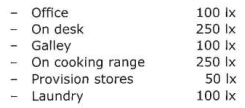
1.4. Operating areas
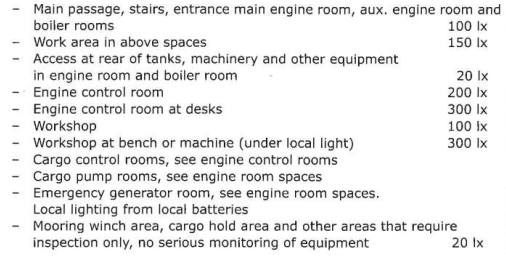
2. Lighting sources
The different types of light sources have very different efficiencies and life times.

When comparing LEDs with traditional halogen spotlights, energy savings of 50% can be attained not only in lighting power, but additionally in the amount of heat produced, which results in less cooling to be done by the air-conditioning system.
Induction lights are not dimmable or available in large types and are considered not suitable for domestic use.
3. Types of lighting systems
Normal lighting systems are all the systems supplied by the main power source.
The normal lighting system has to be arranged in such a way that a fire or other casualty in the spaces containing the emergency generator, transforming equipment and emergency lighting switchboard does not have any effect on the main lighting system.
Emergency lighting systems must be independent of the main power source and the spaces containing it. Emergency lighting can be subdivided into general, transitional and supplementary lighting.
Escape route or low location lighting is required for passenger ships and has to be independent of other fire zones by means of local power supply units with batteries or fire resistant cables, both ensuring availability of the system for one hour.
Transitional emergency lighting must come from a separate battery, rated for half an hour and has to be adequate to permit safe evacuation in an emergency.
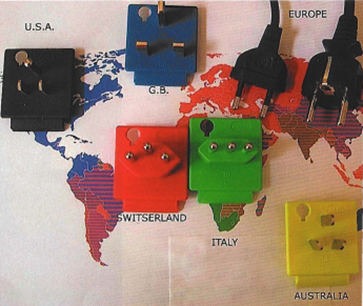
The picture on the previous page (bottom, right) shows various types of plugs for lighting systems. In Europe the two largest countries France and Germany have developed a plug for earthed circuits that fits in both national standards. This plug combines the German rim earth with the French third pin earth and is used now in most European countries. Italy and Great Britain as well as Switzerland are still different but the unearthed European plug fits in the sockets of Swit- serland and Italy.
Lux is the value for light intensity. Lx in short. Lumen is the value for light radiation, or the quantity of light in a lightbeam. 1 Lux = 1 Lumen / sq.m.
4. Lighting Calculations
Making lighting calculations during the design period and using the outcome for the installation helps to avoid costly modifications during completion when the actual lighting levels are measured.
There are many lighting calculation programs on the market, both commercial and non-commercial.
5. Lighting Measurements
On completion the lighting levels should be measured under operational conditions i.e. with all equipment installed and the accommodation spaces with all furniture.
For the lighting measurements a calibrated instrument should be used and the measured data presented in a report. The newer types of lighting measuring instruments have data logging which can be transferred to a PC for further processing.
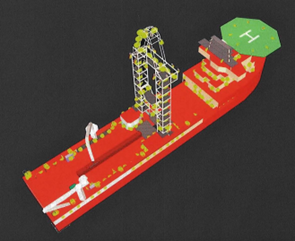
Dialux overview lighting lay-out Drilling Vessel
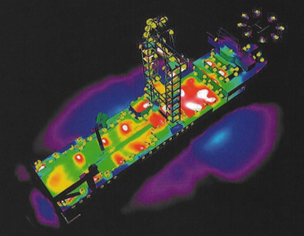
Dialux result of lighting calculations in false colours
 +7 (812) 4-673-673
+7 (812) 4-673-673